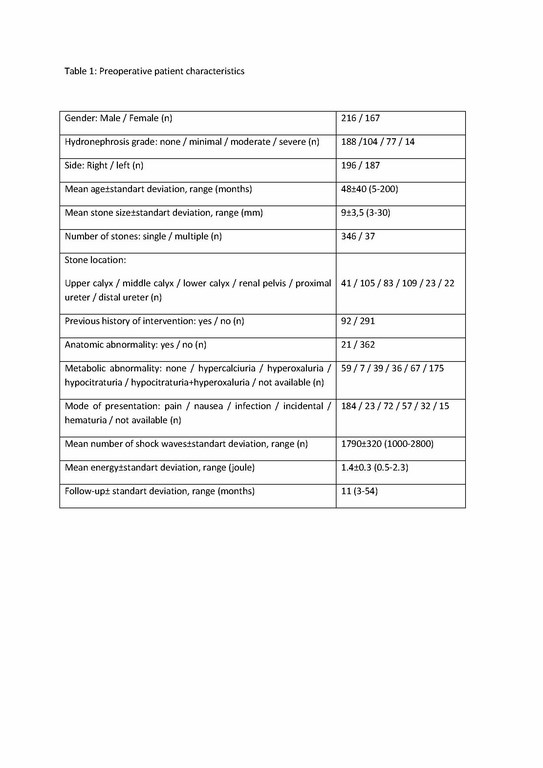-->
|
Back to 2014 Fall Congress Meeting Abstracts
A novel nomogram for prediction of outcome of pediatric shock-wave lithotripsy
Hasan Serkan Dogan, Assoc. Prof., Mesut Altan, M.Di, Burak Citamak, M.D., Ali Cansu Bozaci, M.D., Artan Koni, M.D., Serdar Tekgul, Prof..
Hacettepe University Faculty of Medicine, Ankara, Turkey.
Background:
The present study aims to design a nomogramin order to predict the outcomes of pediatric SWL.
Methods:
The study was conducted in a retrospective design and included 402 renal units who underwent SWL between January 2009 and August 2013. Patients with known cystine stone disease and cystinuria, with internal or external urinary diversion were excluded. Analysis was done in 383 renal units.
Postoperative imaging was done by plain abdominal graphy and ultrasonography with 3 months intervals. Patient who were completely free of stones were considered as success and statistical analysis was done regardingly. Multivariate analysis was done by logistic regression analysis and nomogram was developed .
Results:
Patient characteristics are given in Table 1. The overall stone-free rate was 70.5% (270/383) and efficacy quotient was 57.3%. Mean follow-up was 11±10 months (3-54 months). The number of shock-waves and amplitude of energy were higher in failed cases. Multivariate analysis showed that gender, stone size, number of stone, age of the patient, location of the stone and history of previous intervention were found to be the independent prognostic factors for assessing the stone clearance rates. A nomogram was developed using these parameters (Figure 1). In this nomogram, the points achieved from each parameters are summed and total points correspond to the risk of failure in per cents.
Conclusion:
In most of the pediatric stone cases, SWL is the first line treatment option. The present patient series revealed that gender, stone size, number of stone, age of the patient, location of the stone and history of previous intervention were found to be the independent prognostic factors for assessing the stone clearance rates. This nomogram which is developed on this data might practically be used for predicting the success rates and to inform the parents accordingly.
 
Back to 2014 Fall Congress Meeting Abstracts
|



